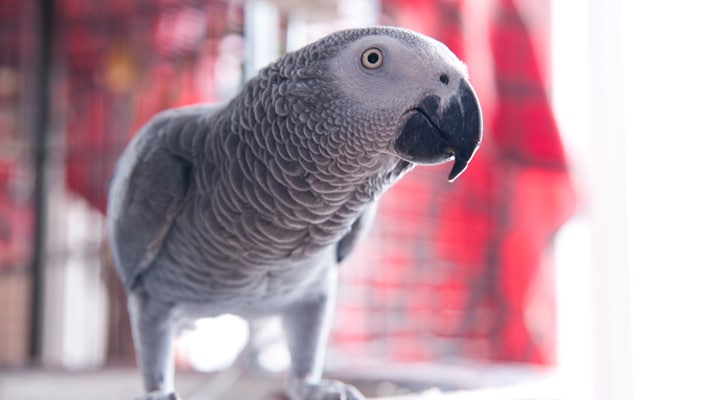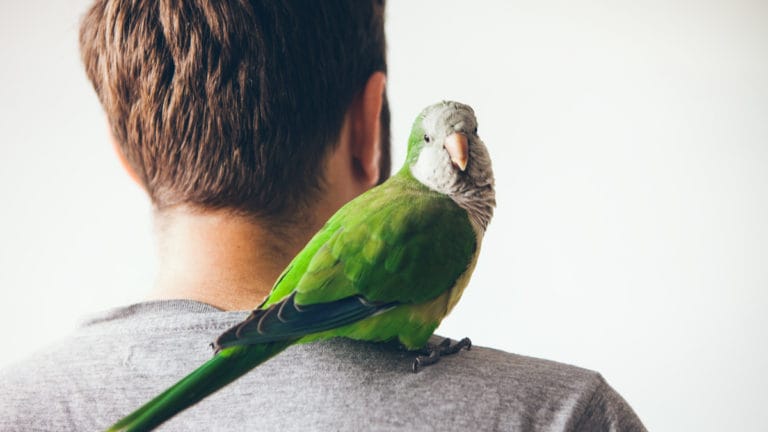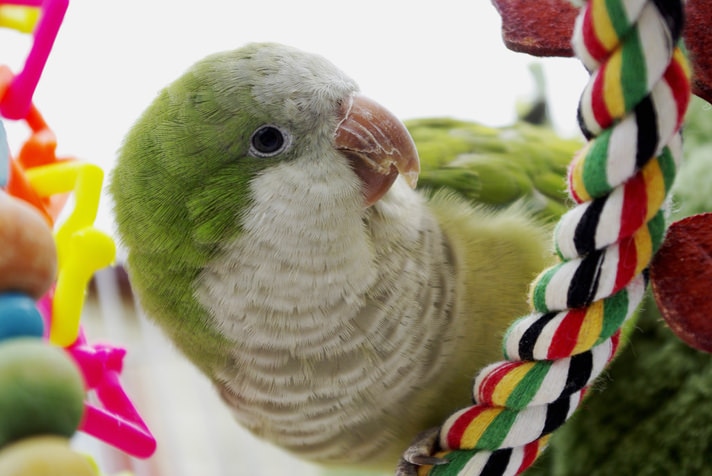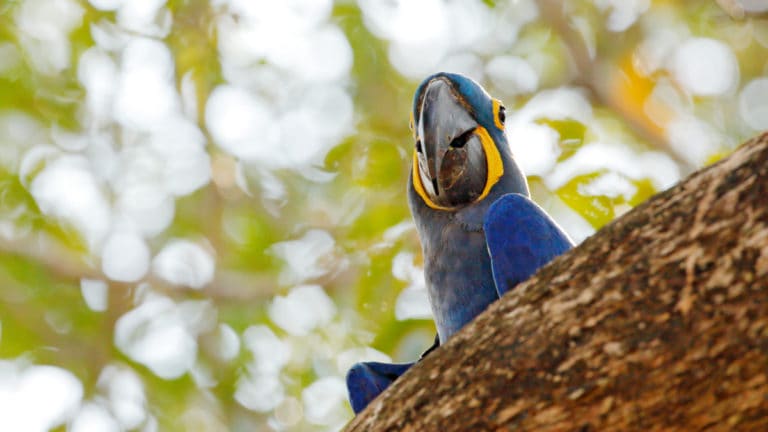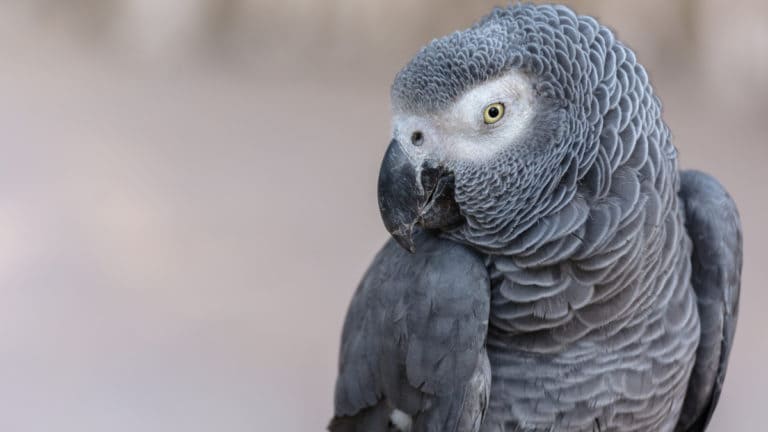During our 20 years together, my African grey has taught me many things about life and living, and she has brought immense joy to my life. In turn, I have learned a lot, not only as an owner but as an avian veterinarian, on the care and housing these great parrots need.
African greys have environmental and developmental needs that are often misunderstood by their owners. If left unaddressed, behavioral and physical problems can arise either early on or much later in life. These problems include aggression, excessive and unexpected fear, and feather chewing. Here are some tips to instill confidence and trust in your African grey.
Don’t Let African Greys Fall
A hard fall, in my opinion, is one of the most important pieces of the puzzle contributing why greys develop so many problems. African greys are heavy-bodied birds and, when they fall, they often hit the edge of the breastbone and come down hard on their legs. This compresses their chest, which pushes air out of their lungs. The force drives up into the shoulders and into the hips, generating pain.
Sometimes they flail their (often over-trimmed) wing feathers and hit their wings against things as they go down. Injuries, such as splitting open the skin over the breastbone or rupturing the skin under the tail, can be common effects of falling. Young greys often start to destroy their feathers in these same areas, which suggests it might be associated with damage from impact.
When your African grey is hurt and scared, it might associate these negative aspects with its owner. A fearful African grey can start to bite or be aggressive. It can also cause further damage to itself by trying to fly away from what frightens it, likely falling again. This is a self-propagating cycle, which, if left unaddressed, can severely affect your relationship with your grey.
Let African Grey Parrots Fledge
One important step toward a well-adjusted African grey is allowing it to “break in its wings,” so to speak. If you have a young grey, do not have its wing feather trimmed just yet. Wait until it has started to learn to fly (i.e. when it can take off and land smoothly and do basic maneuvers, such as turning and landing at its destination).
Once your African grey is proficient at basic flight, consider a light wing-feather trim. A light trim generally refers to trimming the outer five flight feathers to about half their length. With this type of trim, your grey should be able to lift off but not gain altitude. As the bird grows and gains strength, further trimming might be needed even if there is no further feather growth.
Sometimes, an African grey’s feathers are trimmed all at once by the groomer or veterinarian, so don’t hesitate to ask for a very mild trim and return more frequently for “maintenance” trims. The goal of the eventual wing-feather trim is to allow the bird to gently go to the ground in a controlled downward glide over a 7- to 10-foot distance.
Sometimes, a trim is done in such a way that it leaves sharp ends on the quill that rub against and irritate the bird’s side. The bird often responds to this irritation by either chewing on the feathers of the wings or under the wing, and this can lead to further feather chewing. Ask the person trimming your bird’s feathers to leave the outer edges of the feathers slightly longer so they lie smoothly against the bird’s flank.
If your African grey has had a recent wing-feather trim, periodically check the wingtips for evidence of chewing. The tips will appear as shredded and tattered, much like broomstick fiber. These ragged edges can cause further problems as the bird attempts to “soften” or eliminate the rough edges again, thus causing more rough edges.
If your grey starts chewing its feathers in this manner, bring it to the attention of your avian veterinarian as soon as possible so that these tattered feathers can be trimmed before they worsen. If the feathers are shredded, the bird will be attracted to the site and shred more; this can develop to the base of the feather, which allows the feather to break open under the skin, causing infection and pain. This can also lead to further feather destruction and feather picking.
Nails & Perches For African Greys
Nature has given greys (like many African parrots) very sharp, needle-like nails. Greys do a lot of climbing in the wild, and they use these nails to dig into wood to keep them secure while they forage and spend time with the flock.
For an owner, it hurts when these needle-like nails dig into the skin, leaving scratches or painful wounds. Many people have their grey’s nails clipped and, as it often happens, the nails are dulled to the point of the bird not being able to grip a perch firmly. The bird might become more clumsy and nervous because it cannot move without slipping. As a result, the bird might be unsteady and reach out to bite something (a finger, arm, etc) in order to stable itself. This nervousness can develop into fear biting and panic attacks.
Have a grey’s nails clipped to a point that the bird can perch securely and they do not bother you when the bird is perched on your hand. Also, look for bird perches that allow your grey’s foot to go almost all the way around it (but not quite all the way), and vary the type and texture of the perches you give your grey. Natural branches are especially good, as are textured perches, such as concrete or sandy perches (watch for foot irritation). Keep in mind that smooth-barked perches, such as manzanita, add to the slipperiness of the perch and the grey could fall.
Place the perches slightly lower in the cage in case the bird falls off, at least while the grey is very young. As the bird perfects its climbing skills, you can then elevate the perches.
A no-no for almost any parrot, especially a young African grey, is being on a person’s shoulder. Think of your shoulder as a wide and slippery perch, which can make a grey feel unsteady and cause the bird to fall. Have your grey sit on your hand with the elbow lower than the hand to prevent the bird from climbing to your shoulder. Or, sit your grey on your lap or your upper leg while you are seated.
African Greys Might Feel Vulnerable
Many African greys seem to experience anxiety; they chew their nails frequently, flip their wings, move their heads back and forth like they are looking for a place to go, seeming to be unable to sit still. Videos of wild African greys show wary birds with a very strong escape instincts. African greys in the wild are usually foraging in the tree branches, hidden in dense leaves. They are rarely out in a clearing and are on high alert when they are.
In the household, an owner might put their African grey’s cage next to a window, thinking that the bird wants to look out and see everything. Although some greys seem at home with this, other greys appear to feel particularly vulnerable and exposed in this type of housing location (like how a person might feel living in a department-store window).
Move the cage so that the grey can either choose to look out or hide away from what it thinks might be out there. Some birds respond well to having a visual barrier over part of the cage (like a blanket or towel), so they can hide there when they want to. You can also arrange a line of hanging bird toys in front of a perch at the back of the cage to make a little hiding place for your grey. This is one way to provide a sense of visual security, as the hanging toys form a veil the bird can perch behind.
There are a few things you can do to help your grey relax. First, be calm. If you are anxious about anything (including being anxious about your grey being anxious!), this anxiety can be perceived as a signal to your bird that something is wrong in the flock, thus allowing the anxiety to continue. Second, decrease activity around the cage. Place the cage where the grey isn’t constantly exposed to loud noises or children and other pets running by. Provide a hiding place for your grey and ask that guests move slowly around the bird. Third, and most important, whisper in soft tones. I find that whispering softly, and clicking and murmuring, seems to bring the anxiety energy level down in all (including juvenile) greys.
Width Over Height For African Greys
Many of the African greys with behavioral and feather destruction issues that I have seen in my practice are housed in cages that are very tall. It’s a long way down if the bird falls inside the cage, and this can lead to some of the issues discussed. Some birds are frequently allowed on top of the cage and, when either scared, curious or wanting to search for their owner, they leap off in an effort to fly. If they have overly-trimmed wing feathers, they fall, sometimes hitting the corner of furniture on their way to the hard floor.
Bird cages that are shorter, yet very wide and deep, are the best type of cage for an African grey. That way if the bird falls, it decreasing the chances for serious injury.
Keep your bird off the top of the cage to prevent it from falling. Instead, place it on a play stand that’s closer to the ground. Interact with your bird while sitting on the floor, too.
Nail Biting & African Greys
I believe that displaced toenail biting behavior (instead of nails, the bird bites its feathers) is one possible cause for greys that feather-pick. It is unknown why African greys seem to be more prone to this set of behaviors, but, as we learn more about the habits of wild African grey fledglings, there is probably some element of socialization we do not provide for them in our homes and aviaries.
Feather Cleanliness For African Greys
African greys use their powder down and preen glands to keep their feathers well-arranged and soft. Due to frequent exposure to water in their natural habitat, a grey’s feathers are often wet. But, in our homes, excess dirt and oils can build up on the feathers, due to either insufficient bathing with pure water, exposure to excessive oils from our hands, as well as a diet high in fat.
Bathe your grey often with clean water. Distilled water is sometimes required, depending on how much dissolved material and chlorine is in your tap water. Speak to your veterinarian on the best choice of water for your bird.
Wash your hands with soap and water thoroughly before handling your grey, or any other bird. This ensures that the oils from our skin glands, disease organisms or items such as lotions or hand creams do not transfer to our bird’s feathers.
African Grey Speak
African greys are known for their ability to vocalize in our language and especially in context. However, I find that many greys have an inherent language, since several sounds are used by many greys that I have met.
I have seen greys, on their own, make clicks and a “clunk” when they see a food they like. They respond, especially when anxious, to very soft whispers, especially when there are a lot of “Sss” and soft, hissing noises. These are sounds that bonded pairs use during quiet, private times together.
I use these soft whispering clicking and “shooshing” noises when I first meet African greys in the exam room to introduce myself. I find that most of them relax with these sounds, and are easier to handle for my medical care since they seem less frightened and stressed.
By: Dr. Vanessa Rolfe
Feature Image: shrutebucks/iStock/ThinkStocks
Share:
